
The family Phylliidae contains the extant true leaf insects or walking leaves, which include some of the most remarkably camouflaged leaf mimics (mimesis) in the entire animal kingdom. They occur from South Asia through Southeast Asia to Australia. Earlier sources treat Phylliidae as a much larger taxon, containing genera in what are presently considered to be several different families.

Euconocephalus is a genus of bush cricket in the 'conehead' tribe Copiphorini.

Lysiosquillina maculata, the zebra mantis shrimp, striped mantis shrimp or razor mantis, is a species of mantis shrimp found across the Indo-Pacific region from East Africa to the Galápagos and Hawaiian Islands. At a length up to 40 cm, L. maculata is the largest mantis shrimp in the world. L. maculata may be distinguished from its congener L. sulcata by the greater number of teeth on the last segment of its raptorial claw, and by the colouration of the uropodal endopod, the distal half of which is dark in L. maculata but not in L. sulcata. A small artisanal fishery exists for this species.
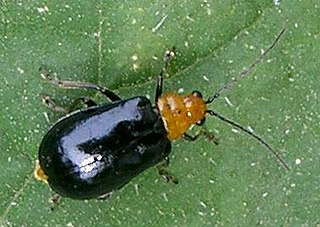
Aulacophora is a genus of beetles in the family Chrysomelidae, commonly known as pumpkin beetles; some species are pests of agricultural crops. The genus was named in 1836 by the French entomologist Louis Alexandre Auguste Chevrolat, in Dejean's Catalogue des Coléoptères. The name, from Ancient Greek, signifies "furrow-bearer"' from aulax, "furrow".

Stomatella is a genus of small to medium-sized sea snails, marine gastropod mollusks in the family Trochidae, the top snails and their allies.

Hexacentrus is the type genus of bush-crickets in the subfamily Hexacentrinae. Most species of this genus occur in Southeast Asia and in Africa.
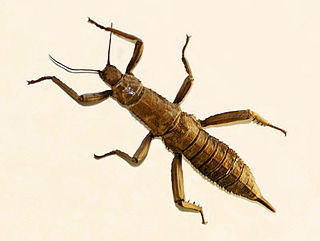
Eurycantha is a genus of Australasian stick insects: typical of the tribe Eurycanthini. It was described by Jean Baptiste Boisduval in 1835.

Mecopoda is the type genus of bush crickets of the subfamily Mecopodinae. Species can be found in India, China, Korea, Japan, Indochina, Malaysia and Melanesia.
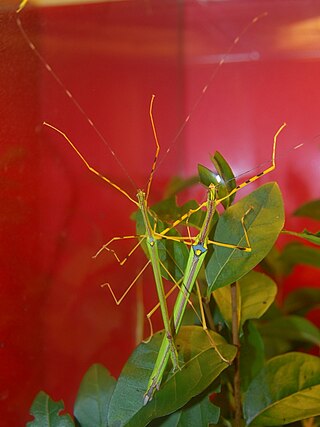
Necroscia is an Asian genus of stick insects in the family Lonchodidae and tribe Necrosciini. Species have been recorded from South-East Asia.

The Lonchodinae are a subfamily of stick insects in the family Lonchodidae found in: Australasia, Asia, Africa, Southern America and the Pacific.
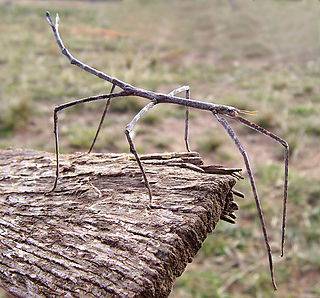
Phasmatini is a tribe of stick insects in the family Phasmatidae. There are more than 40 described species, found in Australasia, and Asia
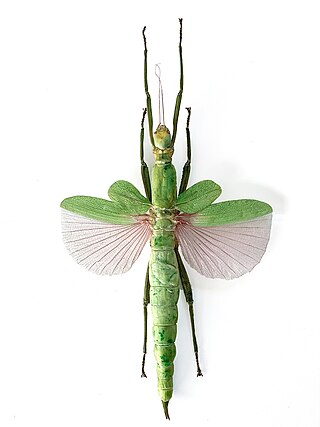
Platycrana is the type genus of the reconstituted subfamily Platycraninae: which are stick insects from the Asia-Pacific region. They belong to the monotypic tribe PlatycraniniBrunner von Wattenwyl, 1893.
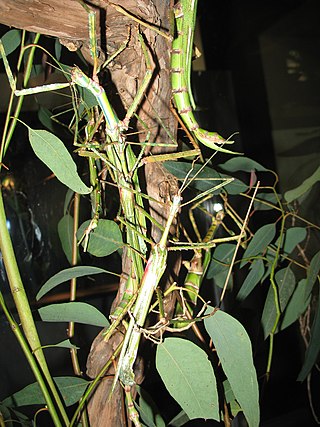
Eurycnema is a genus of stick insects in the family Phasmatidae and tribe Phasmatini. Species have a known distribution from Australia, New Guinea, Kei islands, Timor, Wetar & Solor.
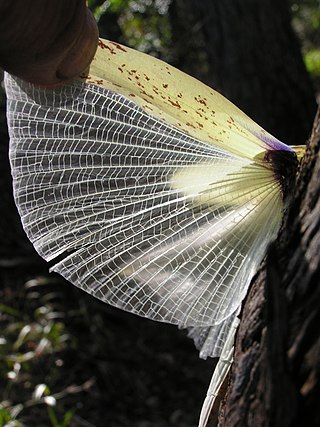
Tropidoderus is a genus of phasmids belonging to the family Phasmatidae.

The Cladomorphinae are a subfamily of stick insects in the family Phasmatidae. This taxon is particularly well represented in the Neotropical region, but records also exist for Madagascar, Java and the Maluku Islands.
Pseudodiacantha is an Asian genus of stick insects in the family Lonchodidae and subfamily Necrosciinae. Members of Pseudodiacantha are excellent examples of camouflage, as they are known to cover themselves in mossy or lichenous outgrowths that supplement their disguise.
Anchiale marmorata is a medium-sized stick insect found in Papua New Guinea. This species is very similar to A. modesta but females are smaller in size and have shorter legs.
Anchiale maculata is a medium-sized stick insect found on the Maluku Islands, Peleng Island and Kei Islands. Anchiale maculata was first described by Oliver in 1792 as Mantis maculata. The genus Anchiale was introduced by Stål (1875) with the type species Anchiale maculata.
Anchiale simplex is a medium-sized stick insect. The existence of this species is questionable. It was described from a single female from French Polynesia in the Museum of Natural History of Vienna, but close examination by entomologist, Frank Hennemann, of the holotype in the Museo Civico di Storia Naturale revealed this species to be too similar to Anchiale stolli from the Bismarck Archipelago and Solomon Islands. Further research is needed.
Scionecra is a genus of Asian stick insects in the tribe Necrosciini, erected by Heinrich Hugo Karny in 1923. Species have been recorded from: China, Vietnam, Malesia through to Australia.















